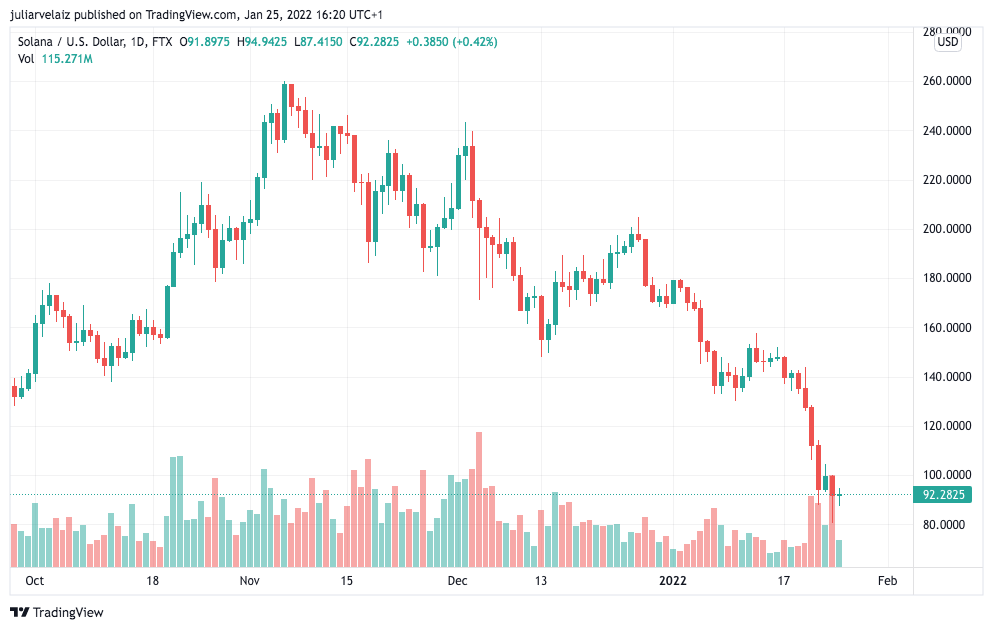These past days could have affected the reputation of Solana (SOL). SOL suffered the most from the crash of the cryptocurrency market, as it was hit with high network congestion.
Here’s What Happened
Last week, it was reported that Solana’s network was clogged, resulting in many failing transactions and DeFi users not being able to adjust their collateral positions to reflect the new valuation of the coin amidst the crypto market fall.
In a Solana blog post, the team explained that the incident experienced by validators was due to excessive duplicate transactions sent by bots and “related to issues previously identified that engineers have been working to improve and resolve”.
It isn’t the first time that the Solana network went down. It is still the worst outage, with an 18-hour interruption to network traffic in September 2021. After the January 4 outage, this is now the second.
Use Liquid Solana
The DeFi lending protocol built on Solana, Solend, stated that the market crash “caused manYou can find it here accounts to become liquidatable and created many profitable arbitrage opportunities.”
The SOL price plummeted dramatically as crypto markets tumbled. Users with collateral had to raise their positions in order not to have assets liquidated. Position liquidators receive a bounty from liquidated positions, so when scenarios like this happen they “race to close eligible positions”, as Laine the blockchain business that operates validators on Solana explained.
This is the reason behind bots, created to help liquidators win the race, but for this, “they submit the same transaction dozens or hundreds of times”. It creates a lot of duplicate transactions that must be checked by validators.
Solend users tried to deposit and pay to avoid liquidations but they were unsuccessful.
“This large load caused validators to falter, especially since they were not filtering out duplicate transactions optimally, wasting precious compute. The thousands of duplicate bot transactions also drowned out legitimate user transactions.”
 Solend further stated, “In addition, there was some erroneous volatility on the Pyth price feed, which caused wrongful liquidations (e.g. some users supplying mSOL and borrowing SOL were liquidated due to prices moving out of sync).”
Solend further stated, “In addition, there was some erroneous volatility on the Pyth price feed, which caused wrongful liquidations (e.g. some users supplying mSOL and borrowing SOL were liquidated due to prices moving out of sync).”
Solend announced later that they were working with users to resolve any issues. The platform will “Reimburse 100% of the penalty for users liquidated due to abnormal volatility on the SOL feed” and “Reimburse 50% of the penalty for other liquidations.”
SOL price tanked
SOL has fallen 42% over the past week. It fell from $144 early Thursday to $80 Monday. The current price is $92,42.
SOL was subsequently displaced as 7th largest coin by XRP. However, overall, SOL experienced the greatest pool of blood from all 20 top cryptocurrencies. Many users are left questioning whether their network is worthwhile.

Similar Reading| Solana Could Flip Ethereum To Become “Visa Of Crypto,” New Study By Bank Of America Shows
What’s Next For SOL?
Solana released the v1.8.14 update to “mitigate the worst effects of this issue” and alleged that “engineers have been working to improve and resolve” the issues related to network congestion starting with the 1.8 release. In the coming 8 to 12 week, there will likely be more updates to v1.9.
“These forthcoming releases are aimed at improving the state of the network, with more improvements expected to roll out in the next 8-12 weeks. Many of these features are currently live on Testnet, where they are being rigorously tested.”
Many users didn’t find relief in the answers from the Solana-supporter CEOs and its co-founder Anatoly Yakovenko and called them out for allegedly doing false claims and dishonest wordplay. It might be at a critical point in its growth. New updates must be able to keep up with demand, and give trust to those who have been disappointed.